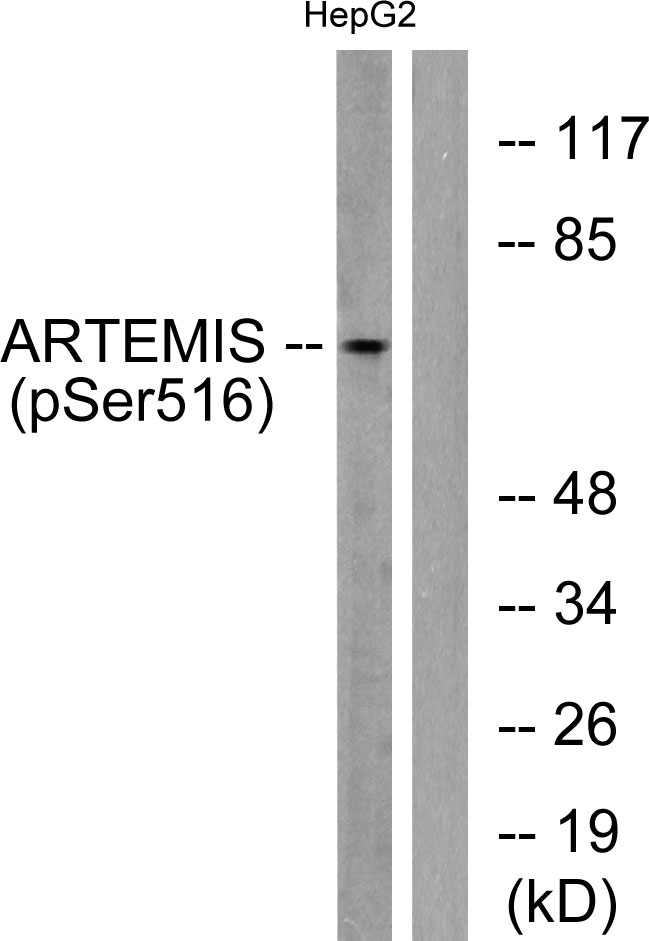Artemis (phospho Ser516) Polyclonal Antibody
- Catalog No.:YP0643
- Applications:WB;IHC;IF;ELISA
- Reactivity:Human;Mouse
- Target:
- Artemis
- Fields:
- >>Non-homologous end-joining;>>Primary immunodeficiency
- Gene Name:
- DCLRE1C
- Protein Name:
- Protein artemis
- Human Gene Id:
- 64421
- Human Swiss Prot No:
- Q96SD1
- Mouse Gene Id:
- 227525
- Mouse Swiss Prot No:
- Q8K4J0
- Immunogen:
- The antiserum was produced against synthesized peptide derived from human Artemis around the phosphorylation site of Ser516. AA range:482-531
- Specificity:
- Phospho-Artemis (S516) Polyclonal Antibody detects endogenous levels of Artemis protein only when phosphorylated at S516.
- Formulation:
- Liquid in PBS containing 50% glycerol, 0.5% BSA and 0.02% sodium azide.
- Source:
- Polyclonal, Rabbit,IgG
- Dilution:
- WB 1:500 - 1:2000. IHC 1:100 - 1:300. ELISA: 1:5000.. IF 1:50-200
- Purification:
- The antibody was affinity-purified from rabbit antiserum by affinity-chromatography using epitope-specific immunogen.
- Concentration:
- 1 mg/ml
- Storage Stability:
- -15°C to -25°C/1 year(Do not lower than -25°C)
- Other Name:
- DCLRE1C;ARTEMIS;ASCID;SCIDA;SNM1C;Protein artemis;DNA cross-link repair 1C protein;Protein A-SCID;SNM1 homolog C;hSNM1C;SNM1-like protein
- Observed Band(KD):
- 78kD
- Background:
- This gene encodes a nuclear protein that is involved in V(D)J recombination and DNA repair. The encoded protein has single-strand-specific 5'-3' exonuclease activity; it also exhibits endonuclease activity on 5' and 3' overhangs and hairpins. The protein also functions in the regulation of the cell cycle in response to DNA damage. Mutations in this gene can cause Athabascan-type severe combined immunodeficiency (SCIDA) and Omenn syndrome. Alternative splicing results in multiple transcript variants. [provided by RefSeq, Jan 2014],
- Function:
- disease:Defects in DCLRE1C are a cause of Omenn syndrome (OS) [MIM:603554]. OS is characterized by severe combined immunodeficiency associated with erythrodermia, hepatosplenomegaly, lymphadenopathy and alopecia. Affected individuals have elevated T-lymphocyte counts with a restricted T-cell receptor (TCR) repertoire. They also generally lack B-lymphocytes, but have normal natural killer (NK) cell function (T+ B- NK+).,disease:Defects in DCLRE1C are a cause of severe combined immunodeficiency autosomal recessive T-cell-negative/B-cell-negative/NK-cell-positive with sensitivity to ionizing radiation (RSSCID) [MIM:602450]. SCID refers to a genetically and clinically heterogeneous group of rare congenital disorders characterized by impairment of both humoral and cell-mediated immunity, leukopenia, and low or absent antibody levels. Patients with SCID present in infancy with recurrent, persi
- Subcellular Location:
- Nucleus .
- Expression:
- Ubiquitously expressed, with highest levels in the kidney, lung, pancreas and placenta (at the mRNA level). Expression is not increased in thymus or bone marrow, sites of V(D)J recombination.
- June 19-2018
- WESTERN IMMUNOBLOTTING PROTOCOL
- June 19-2018
- IMMUNOHISTOCHEMISTRY-PARAFFIN PROTOCOL
- June 19-2018
- IMMUNOFLUORESCENCE PROTOCOL
- September 08-2020
- FLOW-CYTOMEYRT-PROTOCOL
- May 20-2022
- Cell-Based ELISA│解您多样本WB检测之困扰
- July 13-2018
- CELL-BASED-ELISA-PROTOCOL-FOR-ACETYL-PROTEIN
- July 13-2018
- CELL-BASED-ELISA-PROTOCOL-FOR-PHOSPHO-PROTEIN
- July 13-2018
- Antibody-FAQs
- Products Images

- Immunohistochemistry analysis of paraffin-embedded human lung carcinoma, using Artemis (Phospho-Ser516) Antibody. The picture on the right is blocked with the phospho peptide.

- Western blot analysis of lysates from HepG2 cells treated with EGF 200ng/ml 30', using Artemis (Phospho-Ser516) Antibody. The lane on the right is blocked with the phospho peptide.



